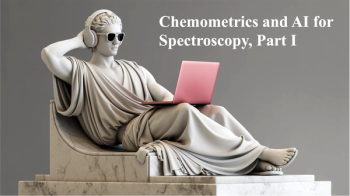
- Spectroscopy-05-01-2009
- Volume 24
- Issue 5
Universal Quantification — The Uncelebrated Strength of ICP-MS
Guest columnist Steven Wilbur discusses the elemental nature of ICP-MS and its strength as a universal quantifier, an aspect of the technique he believes has not received enough attention.
"What if ..." I think this is the most important two-word phrase in the history of human innovation. I would venture to guess that virtually every important breakthrough in human history was preceded by some form of those two words. "What if we could make our own fire?" "What if we could bring water from the river to these fields?" "What if we could fly like birds?" "What if we could reduce our dependence on fossil fuels?" And so on. I like to use it, though mostly without profound results. But, "What if we could quickly and easily quantify any compound we could purify, even in ultra-trace amounts, as long as we knew what it was?" Wouldn't that be something? "If you tell me what it is, I'll tell you how much you have." Simple as that. It does sound simple in fact. You could just weigh it. But what if it is volatile or you don't have enough to weigh? Well then, you could use any of the many quantitative analytical techniques that compare the "response" of the unknown quantity with the "response" of a standard of known quantity. Aha, but what if you don't have a standard, it's unavailable, too expensive, or just not practical. After all there are millions of potential analytes. I know, you could just synthesize a standard, but ... "What if you don't need to?"
Let's set the stage. Most modern "purifications" are done chromatographically or electrophoretically, separating a mixture of compounds into its purified, individual constituents, which are then detected and identified, most commonly using mass spectrometry (MS). The mixture might be an extract of an environmental sample such as a soil or water. It might be a digested food sample, a clinical sample such as tissue, blood, or urine, or another biological sample such as a mixture of proteins or peptides. In all cases, the mixture is separated based upon some physiochemical properties before being passed on to the mass spectrometer. The mass spectrometer then ionizes the unknown components with or without fragmentation into subcomponents, forming charged particles (ions) that can then be detected based upon their mass-to-charge ratio (m/z).
Steven Wilbur
Without fragmentation, the compound might be identified strictly based upon its retention or migration time or mass, if measured with enough accuracy. With fragmentation, the compound might be identified by its fragmentation pattern (mass spectrum), either by comparison with a library of known spectra or through the application of knowledge about how compounds fragment under specific ionization conditions. The goal is to identify the molecular weight, empirical formula, and ideally, the structure of the compound. If a known standard of that compound is available, it can be used to confirm the identity and quantity of the unknown. If not, see paragraph 1.
Molecular mass spectrometers, that is, those mass spectrometers that generate spectra composed of molecular ions or molecular fragment ions, require a calibration standard to provide quantitative information. This is because the number of possible ions and the way they are formed is virtually limitless. Inductively coupled plasma–mass spectrometry (ICP-MS) is different. ICP-MS is an elemental mass spectrometer. The high temperature of the argon plasma (6000–10,000 K) ensures that virtually everything in the sample is reduced to its simplest elemental constituents before analysis. Ideally, the number of possible ions is limited to the number of isotopes in the periodic table, and they are all formed (mostly) through the loss of a single electron. I used the terms ideally and mostly because like nearly everything that seems too good to be true, there is a catch. The catch is this: Although the elemental part of the mass spectrum is indeed simple and representative, the existence of nonelemental interferences can mess up the whole thing. Nonelemental, also called molecular or polyatomic interferences (the term polyatomic is most common), are caused by either the incomplete breakdown of molecular species in the plasma, or more commonly, by the recombination of atoms and ions in the cooler regions after the plasma, creating ions that are not singly charged elemental ions. These polyatomic ions commonly share the same m/z value as some elemental analyte ion, and hence, result in positive bias that is matrix dependent. And, they are quite common. A common example is the interference on arsenic (atomic weight 75) by argon chloride formed in the plasma (molecular weight 75).
For ICP-MS to be truly, universally quantitative, these interferences must be controlled. Traditionally, this has been done through mathematical correction, and more recently, through the use of collision–reaction cell techniques (1). Once the interferences are taken care of, the ICP-MS spectrum is very predictable and exactly represents the elemental composition of the sample. Moreover, the relative response of any element (isotope) can be predicted from the response of any other element (isotope) using well-characterized relationships based upon ionization potential, isotopic abundance, and plasma conditions.
It is this predictability of responses that has endowed ICP-MS with the powerful but under-used capability to do "semiquantitative analysis," or semiquant. Semiquant is the process of quantifying unknown elements in a sample based upon the relative response to another element of known concentration, an internal standard for example.
While it is called semiquant, after the interferences are reliably removed, it actually can be quite accurate, delivering results that are typically within 10–20% or better of the "true" fully quantitative result. Perhaps a better term for semiquant would be "element-independent quantification," meaning that any element can be quantified based upon the response of any other element.
However, for semiquant to be truly reliable, interferences must be managed on all elements. This is because, unlike conventional quantification, semiquant uses the response of one or a few elements to quantify many others. If those reference elements are subject to bias, that bias is propagated through the rest of the results. Additionally, because the semiquant response relationships are dependent upon plasma and other operating conditions, all elements must be acquired under identical conditions. This means that if collision cell technology is used to remove the polyatomic interferences, the same cell conditions must be used for all elements. This rules out any techniques that use reactive cell gases, which are not universal, as well as combinations of gas and no-gas techniques, which are used commonly in normal quantitative analysis. So far, the only collision cell process that meets these requirements is kinetic energy discrimination using pure helium gas. However, under these conditions, semiquant is very simple and reliable.
ICP-MS also has a related attribute called "compound-independent quantification" or compound independent response. This means that, for example, the response of an atom of sulfur is the same in ICP-MS whether it is part of a large peptide or a simple inorganic molecule.
The same rule applies to all elements in essentially all compounds. When properly used, the argon plasma completely converts all molecular species into elemental species before analysis. This feature of ICP-MS permits quantification of known molecular species based upon their elemental composition without the need for specific standards. In this way, we can use the power of the various molecular MS techniques, including electron impact ionization (EI), chemical ionization (CI), electrospray ionization (ESI), or matrix-assisted laser desorption ionization (MALDI) to determine the identity of the unknown molecule and then use ICP-MS to quantify one or more of the elemental constituents, allowing us to accurately quantify the entire molecule. Even without knowing the molecular weight, accurate molar concentration can be determined if the number of metal or other target elements per molecule is known.
Figure 1: Compound-independent calibration table and curve for sulfur-containing pesticides prepared from a single injection into a gas chromatograph with ICP-MS detection.
A well-documented and useful example of this technique is in the measurement of total sulfur in low sulfur fuels (2). In this case, both the concentrations of the individual sulfur-containing components and the total sulfur might need to be known. The identity and concentration of the individual sulfur components are important in the refining process, and the total sulfur concentration is important in the characterization of the final fuel from a regulatory standpoint.
Figure 2: Extracted ion chromatogram, m/z 79 (Br) and 35 (Cl, inverted) of mixture of 50 ppb PBDE mix spiked into 500 ppm total PCB as Aroclors 1016 and 1260.
In this case, a single sulfur compound (thiophene) is spiked into the sample before analysis using gas chromatography (GC)–ICP-MS. From the thiophene response, both the concentrations of the individual sulfur-containing components, whose identity is determined by their relative retention times, and the total sulfur concentration of the sample are calculated easily.
The same technique has been applied successfully to pesticide quantification (3), allowing the accurate measurement of a large number of pesticides using a relatively few standard compounds containing the characteristic elements such as S, P, Cl, Br, and I. In this way, a multilevel calibration can be generated from a single multicomponent standard (as shown in Figure 1) for sulfur-containing pesticides.
In addition to compound independent quantification, ICP-MS possesses nearly absolute specificity, making it simple to locate specific element-containing compounds even in a very complex matrix. Figure 2 illustrates the detection of bromine as polybrominated diphenyl ether (PBDE) flame retardants in a matrix containing a 10,000 times excess of polychlorinated biphenyls (PCBs), which contain chlorine but no bromine. The PBDEs are easily quantified in this matrix.
Quantitative Applications of ICP-MS in Life Sciences
Here is an example of a largely unknown and certainly underutilized tool (ICP-MS) just waiting to solve complex quantitative problems in life sciences research. Quantification of many biomolecules is notoriously difficult using conventional MS techniques, particularly biopolymers, where exact standards are commonly unavailable. However, nearly 30% of all proteins contain a metal as part of the active configuration, making them easily visible to and quantifiable by ICP-MS.
Proteins that do not normally contain a metal ion can be tagged or labeled with specific metals using a variety of techniques (4). A good example is the use of Delphia reagents: europium tagged antibodies, for all kinds of immunoassays. In this case, the selective and quantitative detection of Eu can be used to identify and quantify the target molecule(s), even in complex mixtures.
Most proteins also can be detected and quantified by measuring the sulfur present in the sulfur-containing amino acids cysteine and methionine. Nucleotides (DNA and RNA) can be accurately quantified via the phosphorus concentration. Additionally, it is known that metal ions play a crucial role in the folding of some RNA molecules, thus creating the active geometry of biocatalytic RNA molecules known as ribozymes (5).
Similarly, phosphorylation of proteins can be quantified accurately by simple techniques such as measuring the P to S ratios. When coupled with laser ablation, to vaporize solid tissue samples before introduction into the ICP-MS system, semiquantitative two- and three-dimensional elemental bioimaging is possible (6). In this way, not only can the tagged molecules be identified, but their relative locations and concentrations within the tissue can be mapped and compared.
ICP-MS also can be used as a highly selective screening technique when used with molecular MS techniques. For example, determining all the peaks that contain a specific metal, selenium for example, in a complex chromatogram is simple using LC–ICP-MS, because the ICP-MS system can be set to see only Se, and nothing else. Because most elements have multiple isotopes (Se has six), the presence of additional isotopes at specific ratios can be used to confirm the elemental identity.
When multiple isotopes are available, highly accurate elemental quantification using isotope dilution techniques is also possible. Even when isotopically labeled standards are not available, species nonspecific isotope dilution (7) using a generic isotopically enriched internal standard can provide accurate quantification without compound-specific standards. Because ICP-MS is extremely sensitive (parts-per-trillion or even sub-parts-per-trillion detection limits are common), very small amounts of sample can be measured accurately. This lends itself to parallel configurations with other mass spectrometers as chromatographic or electrophoretic detectors. The outlet of the LC (or GC) column can be split between the two MS detectors with as little as 10% going to the ICP-MS system. The result is negligible loss of information on the molecular MS side with the added advantage of element-specific identification and quantification provided by the ICP-MS side, simultaneously (8).
On the clinical side, the specificity and sensitivity of ICP-MS can permit rapid, trace-level quantification of drugs and metabolites such as the platinum-based chemotherapy drugs in biological fluids and tissues.
Conclusion
So that brings me to my final "what if . . . ," for now at least. What if we could combine element-independent response (semiquant) with compound-independent response? Wouldn't that give us something akin to universal quantification? To my knowledge, this has yet to be tried, but that reminds me of my second favorite question. "Why not?"
Steven Wilbur is a senior applications scientist in the ICP-MS group at Agilent Technologies. He is part of a small but ardent group of fanatics worldwide who believe we will ultimately build the "perfect" mass spectrometer. In the meantime, he spends his time thinking about both living with and eliminating the current "imperfections." The views expressed in this column are his and do not represent those of Agilent Technologies.
References
(1) E. McCurdy and G. Woods, J. Anal. At. Spectrom.19, 607–615 (2004).
(2) B. Bouyssiere, P. Leonhard, D. Pröfrock, F. Baco, C. Lopez Garcia, S. Wilbur, and A. Prange, J. Anal. At. Spectrom. 5, 700–702 (2004).
(3) D. Pröfrock, P. Leonhard, S. Wilbur, and A. Prange, J. Anal. At. Spectrom. 5, 623–631 (2004).
(4) A. Prange and D. Pröfrock, J. Anal. At. Spectrom. 23, 432–459 (2008).
(5) J. Boots, M. Canny, E. Azimi, and A. Pardi, RNA 14, 2212–2222 (Oct. 2008).
(6) D. Hare, B. Reedy, R. Grimm, S. Wilkins, I. Volitakis, J. George, R. Cherny, A. Bush, D. Finkelstein, and P. Doble, Metallomics 1, 53 (2009).
(7) J. Heilmann and K.G. Heumann, Anal. Chem. 80, 1952–1961 (2008).
(8) H.R. Hansen, A. Raab, and J. Feldmann, J. Anal. At. Spectrom. 18, 474–479 (2003).
Articles in this issue
over 16 years ago
Product Resourcesover 16 years ago
Pittcon 2009 New Product Reviewover 16 years ago
Market Profile: LC-MS Time-of-Flight Mass Spectrometryover 16 years ago
Vol 24 No 5 Spectroscopy May 2009 Regular Issue PDFNewsletter
Get essential updates on the latest spectroscopy technologies, regulatory standards, and best practices—subscribe today to Spectroscopy.




